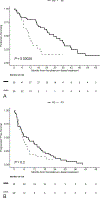Platinum-Based Treatment for Well- and Poorly Differentiated Pancreatic Neuroendocrine Neoplasms
- PMID: 33565789
- PMCID: PMC7880539
- DOI: 10.1097/MPA.0000000000001740
Platinum-Based Treatment for Well- and Poorly Differentiated Pancreatic Neuroendocrine Neoplasms
Abstract
Objectives: Pancreatic neuroendocrine neoplasms include well-differentiated tumors (PanNETs) and poorly differentiated carcinomas (PanNECs). Previous reports suggested a role for platinum-based therapy largely in PanNEC. We sought to investigate the role of platinum-based therapy in pancreatic neuroendocrine neoplasms regardless of tumor grade and differentiation.
Methods: Patients with pancreatic neuroendocrine neoplasms treated with platinum-based therapy at Memorial Sloan Kettering (1994-2016) and Verona University Hospital (2008-2016) were retrospectively identified. Response to treatment by RECIST v1.1, overall survival, and progression-free survival were defined. Among patients with available tissue, DAXX, ATRX, Rb, and p53 expression was evaluated to support the histologic grade of differentiation.
Results: Fifty PanNETs, 29 PanNECs, and 22 high-grade tumors with undeterminable differentiation were included. No patients achieved complete response. Overall rate of partial response was 31%, 41% for PanNEC, and 20% for PanNETs. Among PanNETs, partial response was achieved in 33% of G1 (2/6), 10% of G2 (2/19), and 24% of G3 (6/25) tumors. Median overall survival was 29.3 months for PanNETs and 10.9 months for PanNEC (P < 0.001). There was no significant difference in median progression-free survival (P = 0.2).
Conclusions: Platinum-based therapies demonstrated increased activity in PanNEC; however, promising efficacy was also observed in PanNETs, irrespective of grade.
Copyright © 2021 Wolters Kluwer Health, Inc. All rights reserved.
Conflict of interest statement
D.S.K. is a consultant and equity holder for Paige.AI. The other authors declare no conflict of interest.
Figures



References
-
- Klimstra DS, Klöppel G, La Rosa S, et al. Classification of neuroendocrine neoplasms of the digestive system In: WHO Classification of Tumours Editorial Board, ed. WHO Classification of Tumours: Digestive System Tumours. 5th ed. Lyon, France: International Agency for Research on Cancer; 2019:16.
-
- Garcia-Carbonero R, Sorbye H, Baudin E, et al. ENETS consensus guidelines for high-grade gastroenteropancreatic neuroendocrine tumors and neuroendocrine carcinomas. Neuroendocrinology. 2016;103:186–194. - PubMed
-
- Sorbye H, Welin S, Langer SW, et al. Predictive and prognostic factors for treatment and survival in 305 patients with advanced gastrointestinal neuroendocrine carcinoma (WHO G3): The NORDIC NEC study. Ann Oncol. 2013;24:152–160. - PubMed
MeSH terms
Substances
Grants and funding
LinkOut - more resources
Full Text Sources
Other Literature Sources
Medical
Research Materials
Miscellaneous

